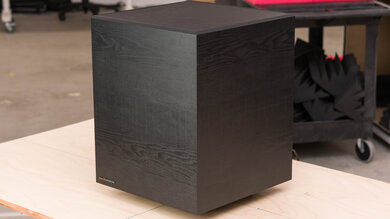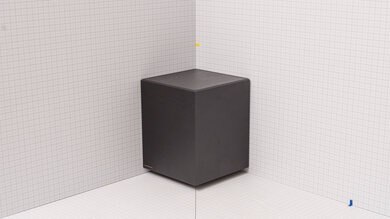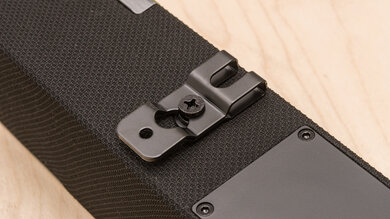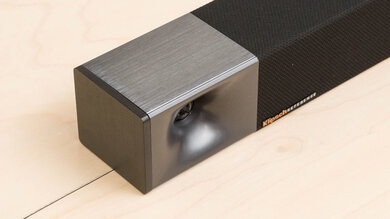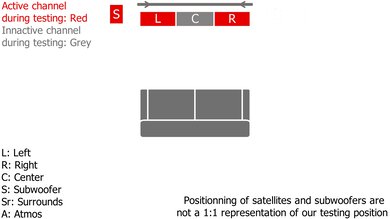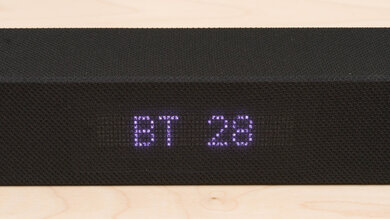The Klipsch Cinema 800 is a 3.1 setup released in 2021. The manufacturer also sells compatible rear satellites, which you can add on separately to improve its surround sound performance. Overall, this soundbar offers very similar performance to the Klipsch Cinema 700, though it has a slightly different design, with more visible plastic horns on each end of the bar. Unlike the Klipsch Cinema 600, this bar supports Dolby Atmos content, though it has to downmix it to stereo to play it back.
Note: The results in this review represent the third model we purchased from the manufacturer. For the first bar we tested, the tweeter blew during our stereo dynamics sweeps, though this won't affect most users since these tests are designed to stress the bar. For the second model we purchased, sound played out of the sub but not out of the bar, meaning we couldn't test it.
Our Verdict
The Klipsch Cinema 800 is great for mixed usage. While it isn't the most premium-looking soundbar on the market, the Klipsch offers a versatile performance that can please many different types of listeners. Dialogue in movies and TV shows is clearly reproduced, and voices and instruments in your favorite tunes are present and detailed, too. Its sub brings out the low rumble in the bass, which is great for bass-heavy music as well as action-packed movies. However, it does downmix audio formats like Dolby Atmos into stereo, which doesn't provide a very immersive feel.
-
Graphic EQ and presets.
-
Extended low-bass.
-
Adjustable dialogue enhancement feature.
-
No room correction.
The Klipsch Cinema 800 is excellent for dialogue-heavy content like TV shows or podcasts. Since it's a 3.1 setup, it has a discrete center channel, which is designed specifically to improve vocal reproduction. Dialogue is reproduced with clarity, making it easy to follow, and its unique 'Dialogue' preset lets you cycle between three different volume levels for voices in the mix.
-
Adjustable dialogue enhancement feature.
-
Night mode.
-
Bluetooth, Wi-Fi, and Chromecast built-in support.
-
Not compatible with Apple AirPlay.
The Klipsch Cinema 800 is great for music. Out of the box, it provides a balanced sound that reproduces voices and other lead instruments with accuracy and detail. Plus, its dedicated sub brings lots of thump and rumble in the bass, great for bringing genres like EDM and hip-hop to life. There's no room correction feature, so it does sound a little different depending on the room you're in, but you can always use its graphic EQ to make up for this a bit.
-
Graphic EQ and presets.
-
Extended low-bass.
-
No room correction.
The Klipsch Cinema 800 is good for movies. Dialogue is easy to follow, and its sub brings out the rumble in action-packed scenes, much like at the movie theater. This bar can playback many of the audio formats that are commonly found on both streaming platforms and Blu-rays, including Dolby Digital and Dolby Atmos. However, since it's a 3.1 setup, it has to downmix this content into stereo to play it, which takes away from the overall immersive feel.
-
Graphic EQ and presets.
-
Extended low-bass.
-
No room correction.
- 7.9 Mixed Usage
- 8.6 Dialogue/TV Shows
- 8.2 Music
- 7.3 Movies
Changelog
- Updated Jun 19, 2023: Following TBU 1.2, added more information to the Audio Format Support: ARC/eARC, Audio Format Support: HDMI In, and Audio Format Support: Optical boxes.
- Updated Jun 19, 2023: Converted to Test Bench 1.2. Updated the results for audio format support via ARC/eARC, HDMI In, and Optical. Added Video Passthrough to TV results as well.
- Updated Mar 01, 2023: Added cable lengths to In The Box.
- Updated Mar 01, 2023: Converted to Test Bench 1.1. With this update, we've added a Mounting test and added information aboutSubwoofer Output, Spotify Connect, and Microphone Mute.
- Updated Jan 16, 2023: Updated the review text for clarity and consistency. No changes in test results.
Check Price
Differences Between Sizes And Variants
This soundbar is available in Black, and you can see the label for the model we tested here.
If you come across another version of this soundbar, let us know in the discussions, and we'll update our review.
Compared To Other Soundbars
The Klipsch 800 is a simple 3.1 setup. Its build quality isn't the most impressive, and it has to downmix surround content into stereo to play it. However, out of the box, it offers a neutral sound profile suitable for many different types of audio content. Unlike many other 3.1 setups, it can even play Atmos content.
See our recommendations for the best soundbars, the best Dolby Atmos soundbars, and the best soundbars with a subwoofer.
Depending on your listening habits, you may prefer either the Sonos Arc or the Klipsch Cinema 800. The Sonos is a 5.0.2 setup that's better built. It has better soundstage, surround, and Atmos performances. There's even a room correction feature and built-in voice assistant support, which the Klipsch lacks. However, the Klipsch has a dedicated sub that can reproduce a thumpier low-bass out of the box. It also has two Full HDMI In ports, meaning you can use it for high-quality passthrough.
Depending on your listening habits, you may prefer either the JBL Bar 9.1 or the Klipsch Cinema 800. If you mostly listen to dialogue-centric content like TV shows, the Klipsch is a solid choice. It comes with a dialogue enhancement feature, unlike the JBL, and it also reproduces a more extended low-bass. However, the JBL is a bit more versatile. It's better built with discrete satellites, and it has better soundstage, surround, and Atmos performances. Unlike the Klipsch, it supports DTS content, too.
The Klipsch Cinema 1200 is a better choice for movies than the Klipsch Cinema 800. The 1200 is a 5.1.4 setup with better surround and Atmos performances. It can play these formats without having to downmix them to stereo. That said, the 800 has a more neutral sound profile out-of-the-box. The 1200's bass-heavy sound adds a lot of extra thump and punch to your audio.
Depending on your listening habits, you may prefer either the Klipsch Cinema 800 or the Sennheiser AMBEO Soundbar MAX. They're both very versatile setups, but the Sennheiser is a bit better for movies. It has better surround and Atmos performances, and unlike the Klipsch, it supports DTS content. That said, its large, heavy standalone design may not be ideal for everyone. The 3.1 Klipsch comes with a dedicated sub, and it reproduces more bass out-of-the-box. It also has a better soundstage.
The Klipsch Cinema 800 and the Klipsch Cinema 700 are very similar soundbars. The 800 has a slightly more neutral sound profile out-of-the-box, and it can reproduce a slightly more extended low-bass, which some users may prefer. Also, its plastic horns are visible, whereas they're covered by fabric on the 700. Also, the 700 has a few more EQ presets.
The Bose Smart Soundbar 900 with Speakers + Bass Module is better than the Klipsch Cinema 800. The Bose is a better built 5.1.2 setup with discrete satellites. It has much better soundstage, surround, and Atmos performances. There are more sound enhancement features, including room correction. However, unlike the Klipsch, it doesn't have a Full HDMI In port for 4k passthrough.
The Klipsch Cinema 800 is better than the Klipsch Cinema 600. The 800 is a 3.1 setup that supports Dolby Atmos content. Unlike the 600, it also comes with two Full HDMI In ports, which you can use for high-quality passthrough.
The Klipsch Cinema 800 and the Sony HT-A3000 are both 3.1 soundbars that can playback Dolby Atmos content by downmixing it into stereo. The Klipsch is better, though, as its dedicated sub means it can reproduce more low-bass. It has a better soundstage, too, as well as more customization tools. With an HDMI In port, too, you can use it for video passthrough, unlike the Sony. That said, the Sony model supports DTS content, unlike the Klipsch.
The Klipsch Cinema 800 is better for mixed usage than the Sonos Beam (Gen 2). The Klipsch is a 3.1 setup with a dedicated subwoofer that can reproduce a more extended low-bass. It also gets louder with less compression at max volume. However, if you prefer a smaller standalone bar, the Sonos is still a great choice. It's a better-built 5.0 setup with better soundstage, surround, and Atmos performances.
Depending on your listening habits, you may prefer either the Klipsch Cinema 800 or the standalone Bose Smart Soundbar 900. The Klipsch is a 3.1 setup that comes with a dedicated subwoofer. It can reproduce a more extended low-bass, and unlike the Bose, it has a Full HDMI In port for high-quality passthrough. The 5.1.2 Bose is better built with better soundstage, surround, and Atmos performances. It also has built-in voice assistant capabilities, and you can even upgrade it with a sub and satellites.
The Samsung HW-Q700A and the Klipsch Cinema 800 are both similar 3.1 setups. The Klipsch is able to reproduce a more extended low-bass. However, the Samsung is better built with a better Atmos performance thanks to its two up-firing drivers. It also has DTS support.
The Samsung HW-Q800A is better than the Klipsch Cinema 800. The Samsung is a better built 3.1.2 setup with a better Atmos performance. Unlike the Klipsch, it also has built-in voice assistant capabilities and DTS support.
The Samsung HW-Q950A is better than the Klipsch Cinema 800. The Samsung is a better built 11.1.4 setup with discrete satellites. It gets louder, and it has better surround and Atmos performances. It even comes with more sound enhancement features, such as room correction. Unlike the Klipsch, it has DTS support and built-in voice assistant capabilities.
Depending on your listening habits, you may prefer the Klipsch Cinema 800 or the Sonos Arc with Sub + One SL Speakers. The Sonos is a versatile 5.1.2 setup with discrete satellites. It's better built, and it has better soundstage, surround, and Atmos performances. There are even more sound enhancement features, including room correction. That said, the 3.1 Klipsch has more bass out-of-the-box. The Klipsch is ideal for users who prefer to plug-and-play, but you can always use the Sonos' bass and treble adjustments to create a more neutral sound profile if you prefer.
The Klipsch Cinema 800 is better than the standalone Bose Smart Soundbar 700. The Klipsch has a dedicated sub, meaning it can reproduce a more extended low bass. Unlike the Bose, it also supports Atmos content. However, the Bose is better built and even has built-in voice assistant support. You can also upgrade it to the Bose Smart Soundbar 700 with Speakers + Bass Module for better performance.
The Klipsch Cinema 800 is better than the Klipsch Bar 48. The Cinema 800 supports Dolby Atmos content, unlike the Bar 48. The Cinema 800 also has a better soundstage and a more neutral sound profile out-of-the-box. However, the Bar 48 is better built.
The LG SP9YA is marginally better for mixed usage than the Klipsch Cinema 800. The LG is a 5.1.2 setup that's better built and offers better Atmos and surround performances. It comes with more sound enhancement features, including room correction. That said, the 3.1 Klipsch can reproduce a more extended low-bass. It also has a better center channel performance.
The Samsung HW-Q900A is better than the Klipsch Cinema 800. The Samsung is a 7.1.2 setup that's better built. It has better surround and Atmos performances, and it gets louder. Unlike the Klipsch, it supports DTS content and built-in voice assistant capabilities. It even has some more sound enhancement features, like room correction. However, the 3.1 Klipsch is still a solid choice for dialogue-centric content like TV shows.
The Samsung HW-Q950T is better than the Klipsch Cinema 800. The Samsung is a better built 9.1.4 setup with discrete satellites. It has better surround and Atmos performances, and it gets louder. Unlike the Klipsch, it supports DTS content and built-in voice assistant capabilities. However, the 3.1 Klipsch is still a solid choice for dialogue-centric content like TV shows.
The Vizio M Series M51a-H6 is better for mixed usage than the Klipsch Cinema 800. The Vizio is a better-built 5.1 setup with discrete satellites. It has better surround and Atmos performances. Unlike the Klipsch, it supports DTS content. However, the 3.1 Klipsch has a better soundstage. It can also reproduce a more extended low bass.
The Klipsch Cinema 800 is better than the Samsung HW-Q600A. The Klipsch has better soundstage and surround performances. It can also reproduce a more extended low-bass. That said, the 3.1.2 Samsung is better built with a better Atmos performance.
The Klipsch Cinema 800 is better than the Sony HT-Z9F. The Klipsch is a better-built setup that can reproduce a more extended low-bass, so you feel more thump and rumble in your audio. It also has a better soundstage performance. The Sony doesn't have to downmix surround and Atmos content into stereo to play it like the Klipsch. Instead, it uses phantom localization, which sounds a bit more clear and real.
Depending on your listening habits, you may prefer either the Klipsch Cinema 800 or the Sony HT-A7000 with Speakers + Bass Module. The Sony is a better-built 7.1.2 setup with discrete satellites. It's better for movies, thanks to its Atmos and surround performances. Unlike the Klipsch, it also supports DTS content. That said, the Klipsch is still a really good choice for dialogue-heavy content and music. It can reproduce a more extended low-bass, and it can get louder with less compression at max volume.
Depending on your listening habits, you may prefer either the Bose Smart Soundbar 700 with Speakers + Bass Module or the Klipsch Cinema 800. The Bose is a 5.1 setup that's better built. It comes with discrete satellites, and it has better soundstage and surround performances. Unlike the Klipsch, it also has built-in voice assistant support. However, only the Klipsch supports Dolby Atmos content. It also has a Full HDMI In port for high-quality passthrough, unlike the Bose.
The Klipsch Cinema 800 is better than the Samsung HW-Q60B. They're both 3.1 setups with Dolby Atmos support, but the Klipsch offers a better soundstage. It's also able to reproduce a more extended low-bass, so you feel more thump and rumble in your audio. There are more wireless playback options on hand, too. That said, the Klipsch doesn't have a very premium build, especially compared to the Samsung.
The Klipsch Cinema 800 is better than the Samsung HW-B650 for most uses. They're both 3.1 bars, but the Klipsch can reproduce more low-bass, so you feel the rumble in bass-heavy music genres. It has a better soundstage, too, and unlike the Samsung, there's Dolby Atmos support to help you take advantage of more immersive object-based formats, though its performance isn't the best.
Test Results
The Klipsch Cinema 800 is mostly made of plastic, and the top, front, and part of the bottom of the bar are covered with fabric. It has a similar design to the Klipsch Cinema 700, but the plastic horns at the end of the bar are visible.
You can purchase satellites from Klipsch separately.
The Klipsch Cinema 800 has a fair build quality. The bar is mostly made of plastic, though it doesn't feel very premium. The bar's fabric covering seems like it could rip or collect dust easily, too. On the right side of the bar, there's a removable panel that lets you access the USB ports for servicing the bar and connecting additional speakers. The sub is mostly made of wood, which feels pretty solid.
Note: The results in this review represent the third model that we purchased from the manufacturer. For the first bar we tested, the tweeter blew during our stereo dynamics sweeps, though this won't affect most users since these tests are designed to stress the bar. For the second model we purchased, sound played out of the sub, but not out of the bar.
The Klipsch Cinema 800 has an excellent stereo frequency response. Right out of the box, it offers a balanced sound profile that reproduces voices and lead instruments with clarity and detail, making it suitable for a wide range of music genres. Its subwoofer brings plenty of rumble in the low-bass, meaning you can feel the thump in bass-heavy genres like EDM and hip-hop. If you prefer a different sound, you can customize it using the graphic EQ in its companion app.
If you prefer a more balanced sound with stereo content, we recommend using the bar with its default settings.
The Klipsch Cinema 800 has a good stereo soundstage. The soundstage is perceived to be as wide as the bar itself, though it doesn't have any tricks to make it seem wider than that. However, it has good focus, so objects like voices seem to come from an accurate, pinpoint location in the sound image.
The Klipsch Cinema 800 has a very good stereo dynamics performance. It gets loud enough to fill most rooms with sound. Plus, there isn't a lot of compression as you turn up the volume, ensuring that audio reproduction remains clean and pure at loud volume levels.
The Klipsch Cinema 800 has good stereo THD performance. At a normal listening volume, distortion falls within good limits, resulting in clean and pure audio reproduction. While there's a slight jump in THD at max volume, ultimately, this isn't very noticeable with real-life content.
The Klipsch Cinema 800 has an impressive center channel performance. Its discrete center helps to more accurately localize voices to a pinpoint location in the sound image. Also, its frequency response is neutral in the mid-range, where most vocals are reproduced. As a result, dialogue is clear and detailed, though higher frequencies can also be alternately harsh or dull due to the uneven treble.
The bar can playback 5.1 surround sound formats like Dolby Digital, which you can find on both streaming platforms and Blu-rays. However, since it's a 3.1 setup, it has to downmix surround content into stereo to play it. The resulting sound isn't quite as immersive, and you don't get the sense of sound effects coming from all around you. If you want an improved surround sound, you can purchase satellites from the manufacturer separately.
This soundbar supports Dolby Atmos content, which is an immersive audio format commonly found on streaming platforms and Blu-rays. However, to play this content, the bar has to downmix it into stereo. As a result, it can't replicate the same sense of height, so you don't get a very immersive feel. Sound effects seem like they're coming from a speaker placed in front of you rather than from all around your couch.
Subjectively, downmixing Atmos content into stereo certainly takes away from the all-around immersive feel. However, we felt that the bar didn't perform quite as poorly as the score suggests. Its subwoofer offers solid performance with thump and rumble in the bass while remaining controlled. Plus, it simulates a wide stereo soundstage, so sound extends a little past the edges of the bar itself. Of course, it's not as impressive as more premium models with true Atmos support, as the bar struggles to simulate height. For example, drones that are meant to fly overhead just seem like they're coming from the speaker in front of you.
This soundbar has a fair selection of sound enhancement features. There's a 3-band graphic EQ to help you customize its sound, as well as three EQ presets: 'Standard', 'Dialogue', and 'Night'. The 'Dialogue' mode lets you cycle through three different levels, meaning you can control the volume of the dialogue in your audio. The 'Night' preset disables the subwoofer and reduces the dynamic range, which is helpful if you want to watch TV at night.
You can connect this soundbar to your TV via HDMI ARC and Optical Audio In, and there are even two Full HDMI In ports if you want to use it as a hub between different devices. There's also an Ethernet port to connect it to your network, as well as a Sub Out port.
This soundbar has amazing audio format support via ARC. It supports Dolby Digital, which is the most common surround sound format. It can also play lossless and object-based surround sound formats like Dolby Atmos and has eARC support. However, unlike the Sony HT-A3000, it doesn't support DTS content. Also, when you play Dolby Digital or Dolby Digital Plus content, any dedicated left or right audio plays on both channels simultaneously. This is also true with the left and right surround channels, meaning that sound effects aren't as accurately localized within the soundstage. For example, a voice meant to come from the left seems like it's coming from the left and right simultaneously, which doesn't give you the same life-like feel.
This soundbar also has excellent audio format support via Full HDMI In. It can playback common surround sound formats like Dolby Digital and lossless and object-based formats like Dolby Atmos. That said, it doesn't support DTS. The same implementation issue is present over this connection, and with Dolby Digital and Dolby Digital Plus content, any dedicated left or right audio plays from both channels simultaneously, which takes away from the overall immersive feel.
Via Optical, this soundbar supports Dolby Digital content. You can find this surround sound format on many Blu-rays and streaming platforms. That said, any dedicated left or right audio plays on both channels simultaneously with this content, so you don't get the same clear and real feel with sound effects as you do with bars that provide a correct implementation.
This soundbar has excellent latency performance. It has fairly low latency via ARC and Optical, so the audio you hear is in sync with the video you see. As a result, it's a great choice for watching videos and movies, and you don't notice any lip-synching issues. Since different TVs and apps can compensate for latency differently, your real-world experience may vary slightly.
This soundbar can passthrough some of the highest bandwidth signals, including Dolby Vision Passthrough. When it's connected between different devices like a PC and a TV, text on your screen appears crisp and clear.
You can stream audio from other devices to the bar over a wireless connection.
The remote has a similar design to that of the Klipsch Cinema 600. It lets you control all the bar's features, including the volume and the inputs.
The manufacturer says that the Klipsch Cinema 800 supports voice assistants if you connect it to a voice-assistant-enabled device that supports Amazon Alexa or Google Assistant. However, you need to purchase a third-party device to use this feature.
Comments
Klipsch Cinema 800: Main Discussion
Let us know why you want us to review the product here, or encourage others to vote for this product.
Update: Following TBU 1.2, added more information to the Audio Format Support: ARC/eARC, Audio Format Support: HDMI In, and Audio Format Support: Optical boxes.



